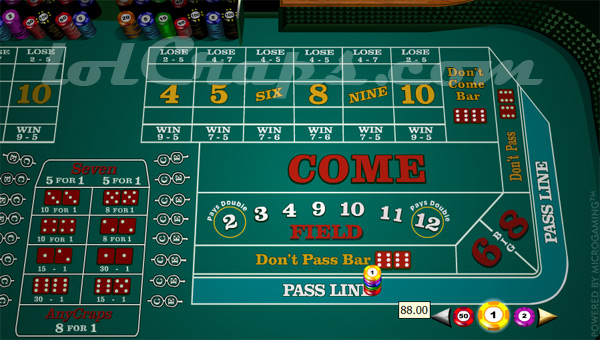Cheating at craps using fixed, rigged and loaded dice
There are a number of ways to cheat at the game of craps. Using fixed dice is one of the oldest methods of cheating at dice games and there are a number of ways that players can manipulate the dice. Basically, the main idea is that the dice get altered in some way so that when they are thrown, they land on specific numbers more often than others. Then the cheating players wager on those same numbers and wins more money. The dice do not always land on the numbers but the probabilities change, giving cheaters a larger mathematical edge over the house in the long run. I will explain how the dice get rigged and information about different variation of rigged dice.
Fixed dice are also known as rigged dice, loaded dice and gaffed dice among other names you may have heard. Below is a list of other names for specific changed dice:
Properties and types of loaded dice
Weighted Dice - As the name states, these are dice that have some additional weight put on them in order to change the center of mass and alter how they will land on the table. Usually, there will be some type of heavy metal like lead, but also platinum or gold. These heavier metals have a higher density, meaning you do not need as much of it in order to get the right effects. Players sometimes put the metal inside one of the white dots on the dice, also known as a pip. The desired effect is to have one side of the dice heavier so it lands on a specific face. If these dice are inspected by an expert, sometimes one of the dots will be deeper than the rest.
Tappers - These are dice with a shape inside that resembles a dumbbell. These dumbbells can be aligned in various ways. For example, one end of the dumbbell might be in one corner of the die and the other side is in the center. In addition, this chamber will sometimes be filled with mercury, which is that liquid silvery metal which happens to be very dense as well.
When the mercury is in the center of the die, they will appear and feel normal. When the player taps on the dice right before they are thrown, the mercury will move from one side of the dumbbell to the other side, which is in the corner. This is where the term "tappers" comes from. Another type of tappers side consists of a small ratcheting mechanism that holds a weight until it is tapped, but it requires rubber inside to prevent noises inside the dice. Many casinos nowadays have transparent dice so people can no longer hide these things inside the dice. A lot of times, these dice will not work anyways with the weight being shifted around all over when they are thrown.
Floaters, also known just as floats are dice with hollow interiors. They will weigh slightly less and "float" a little more on one end. These kinds of dice work similar to weighted dice in that one end is hollowed out in order to make the opposite end heavier and more prone to being rolled.
Different types of shaped dice and how to rig them
Shaped Dice - A pair of shaped dice is similar to a set of shaved dice, except the sides are shaped into a parabola or curve. Usually they will have convex or concave designs to them (like a hill or valley). One side will usually be altered to give the dice a biased roll.
Beveled Dice - A type of dice that is shaped into a convex on one or more sides. This convex impression acts like a hill or slightly raised surface which tends to make the dice roll off of that side and land on a flat surface.
Suction Dice - These are opposite of the beveled dice in that one side is concave. The concave side acts like a "cave" or valley which produces a suction effect on the table. This vacuum tends to make the concave side stick to the table.
Mis-spotted Dice, also known as tops, horses and tees, mis-spots and tops and bottoms - These are dice that have one of the sides duplicated. For instance, opposite sides of the dice will add up to 7 on a normal pair of dice. A mis-spotted pair will have the same number on both sides of the dice. That means that one number will be missing from the dice but they will roll on a seven more often than normal. Obviously, this is something that is very easy to spot with both sides of one die having the same number. Still, people may not think about it and they can remain in the game if the dealer is not checking them.
Raised Spots - These are dice that are very easy to spot because the white spots are raised into little bumps. This is used to bias the roll and they are usually used in practice since they would be noticed right away in a real casino. The idea is that the dice will tend to roll off of the raised bumps or pips and land on a different surface.
A variety of ways to shave the dice
Shaved Dice - These kind of dice, sometimes known as barred or bricks, are different because they do not use additional weights. Instead, people will shave or grind down part of the dice in order to change the shape. Usually they will be formed or created somewhere so the shave scratches are not so obvious in a casino. The idea is to give it more of a rectangular shape instead of square cubes. Only one side will be shaved, meaning 4 sides will be shorter and have less surface area. In the end, the shaved side and its opposite side will show up more often.
Cut Edge - This is one of the variations of the shaved dice. When one of the cubes has a cut edge, that means one edge will be shaved at 45 degrees and the rest of the edges will be shaved at 60 degrees.
Raised Edge - These are dice were some of the edges have a slight alteration that produces a lip on one side, which will increase the surface area. In turn, this will produce a gripping effect on the craps table.
Razor Edge - The razor edge is a different variety of shaved dice where cheaters will cut one edge with a razor. The other ends will be altered until they are slightly rounded and turned. The idea is that the dice should roll and the razor edge will grab onto the table while the rounded edges will make the dice continue to roll.
Saw Tooth Edge - These are similar to dice with a razor edge, except that one of the edges will have jagged saw tooth indentations that will grab onto the table more effectively, much like a series of hooks.
A flat passer is a name for a single shaved die on the 3 or 4 side and a normal die. The numbers 4, 5, 9 and 10 tend to get rolled more frequently. A six-ace flat is known for when one of the die have the 1 or 6 side shaved. Finally a flat passer is a name give to the dice when one die has the 1 and 6 shaved and the other dice has the 3 and 4 shaved.
Capped Dice - This variety of dice usually involves shaving down one of the sides and then filling the gap with a different material that looks the same. This material will have different properties such as a heavier mass or higher density. Other materials can be more elastic to produce a bigger bounce on the capped end. This is a clever method to make the dice appear normal, but they do start to look different when wear and tear takes place. Craps dealers can also use their fingernail to see if one of the sides pushes in more than normal as well.
Painted Dice - These are dice that have some type of substance painted onto them. Commonly, this material will become sticky when moisture is applied, sort of like using water to active the sticky properties. This can be done by blowing on the dice right before a roll, using sweaty hands or getting your fingers went with a drink. The idea is to make a biased roll by having the dice stick to the table surface. This is kind of a risky way of fixing the dice because too much of this material might make the dice stick to the table without ever bouncing, or picking up chips and other things on the table that would blow the cover.
Slick Dice - Like the name says, one side will be polished and make "slick" and other sides will be roughed up. This is actually a safe way to make rigged dice because this usually happens on its own with natural wear and tear. The idea is that the rough sides will grab onto the table like hooks and the polished sides will keep rolling due to the lack of friction.
Bristled Dice or bristles are dice that have a sharp protrusion such as a pin put into one of the center dots or pips on the dice. This is one of the oldest forms of rigged dice and they are very easy to spot by players and the dealer. Basically, this pin will stick out just slightly enough to grab onto the felt on the craps table but not enough to hurt the fingers. The term bristles came to be when people in the old days used to use coarse hair from farm animals such as horses or cows.
In summary, you can see that there are tons of different ways to rig and fix the dice in order to cheat at craps. Some of these methods are very clever and intelligent, which can allow for cheaters to actually use these in a live casino setting and in craps. Others are easily spotted and obsolete to use, but were effective in the past. While we do not recommend cheating, this article is very interesting for people who are curious about the topic.
Read more of our pages for information about other methods of cheating at craps. Also, there is another way to gain an advantage at craps without illegally cheating and it is a skill similar to card counting in blackjack, except craps players learn how to control the dice.


 US Players and Credit Card, BitCoin Deposits Accepted!
US Players and Credit Card, BitCoin Deposits Accepted!


